#ADHD Symptoms
Text


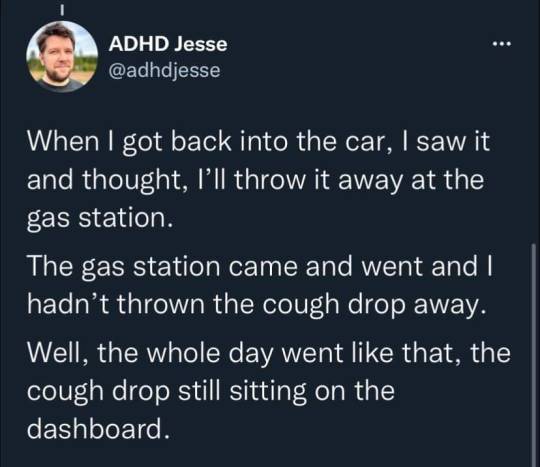



Neurodivergent Things
#adhd symptoms#adult adhd#adhd problems#adhd brain#neurodivergence#neurospicy#neurodivergent#neurodiversity#nuerodivergent#nuerodiversity#nuerospicy
100K notes
·
View notes
Text
Did you kNoW?
Stimulants affect people with ADHD differently because our brains are not processing the naturally produced dopamine as effectively as a neurotypical brain would. The stimulant helps boost us to a 'normal' feeling level.
This is why when a neurotypical person takes ADHD medication they have extreme bursts of productivity and write their thesis in one night or I dunno remodel their house, while an ADHD person might just take them and be like 'Hooray I managed to wash my clothes and hang them up in the same day!'
Jokes on them though, because I can drink coffee at 11pm and sleep right after. Take that society.
#neurodivergence#adult adhd#adhd#neurodiversity#adhd brain#adhd things#neurodiversesquad#executive dysfunction#stimulants#medicated adhd#caffeine#late diagnosis#adhd symptoms#adhd superpower
2K notes
·
View notes
Text
One of the symptons of ADHD is emotional dysregulation MEANING I get to tell people "I love you so much I need pills to manage it".
#adhd symptoms#emotional dysregulation#I did this with my family#i won't say this to anybody else#until we're in a 3 year relationship#adhd awareness#adhd problems#adhd brain#actually adhd#adhd things#adhd#mental heath#nerodivergent#nerodiversity
614 notes
·
View notes
Text
The two ADHD moods:
I can't do it.
I can't stop doing it.
The two types of ADHD time:
Now.
Not now.
The two ADHD memory modes:
I literally cannot recall the words that just came out of my mouth.
I can recite the opening paragraph of every single magic treehouse book.
Unknown Source
#adhd mood#adhd time management#adhd memory#adult adhd#adhd problems#adhd symptoms#adhd#idk the author
2K notes
·
View notes
Text
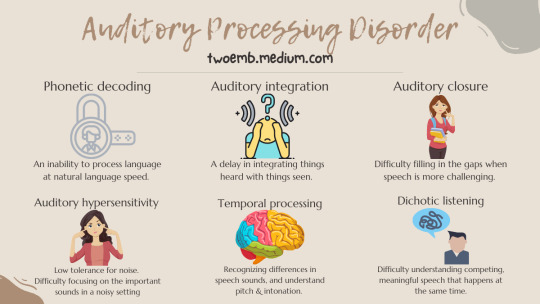

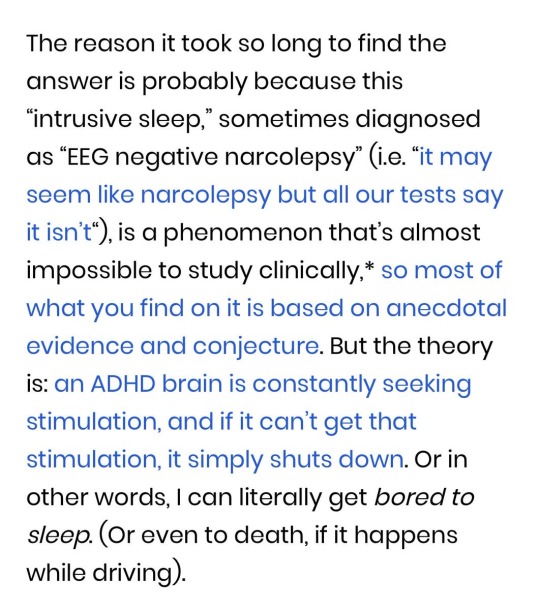
Ask box is open and I am taking poll suggestions
#yes I made this one to be educational#we need to talk about these symptoms more#and just how disabling adhd can really be#fuck marry kill#fmk#fmk game#fmk poll#poll#polls#tumblr polls#adhd#adhd symptoms#apd#adhd apd#auditory processing disorder#rsd#adhd rsd#rejection sensitive dysphoria#intrusive sleep#adhd intrusive sleep#adhd sleep
155 notes
·
View notes
Text
My doctor had me do an ADD test a few months ago.
It was a short questionnaire relating to the past 6 weeks, about a third of which wasn't relevant because it specifically pertained to school, and a couple of tests requiring me to hit the space bar whenever I heard a particular sound or saw a particular letter.
The doctor said the results didn't indicate ADD.
Now, I don't really believe in self diagnosis, but the kinds of things I've said that have made professionals think I may have it have nothing to do with focusing on a single task on a computer in a small silent room.
Idk, I feel like that test is out of date or something.
I get lost in my own house.
#adult adhd#adhd symptoms#adhd#adhd problems#adhd brain#actually adhd#adhd things#adhd tests#add tests
170 notes
·
View notes
Text
Common ADHD traits/experiences I've heard of !!
(I was gonna make a post about why I might be neurodivergent but I figured it'd be going a bit too personal. Also this is just easier)
(ADHD is much more nuanced and complex than I may make it appear in this post. A lot of ADHD people don't have a lot of these traits or have traits not mentioned here. For example there are three types of ADHD (inattentive, hyperactive and combined) and most inattentive adhders are not going to be hyperactive lol)
Warning: badly worded (I'm stupid that's my excuse). also I'll go on personal rants as to how some of these may apply to me (whilst I can reasonate with each point listed here I won't go on a rat on all of these)
Physical hyperactivity (inability to sit/stand still (I used to think this meant that people with ADHD were incapable of. Sitting down (while constantly fidgeting or not) for one whole class)(I was an idiot)(I still am)). (Just overall constant , movement (I might have it idk I'm ALWAYS
Excessive talking
Stimming, fidgeting, general and overall repetitive movements (such as flapping hands, pacing, clasping hands together, etc)
Low attention span regarding things that don't garner much interest to you
More likely to be autistic, have anxiety or depression (or generally have other diagnostic conditions)
Ability to Hyperfocus on specific things, at times out of their control
More likely to have a lower Performance in school that most people
Proneness to addiction
Rejection sensitive dysphoria/RSD (really sensitive and afraid to rejection or criticism or disapproval or stuff like that. I'm questioning if I have it and I'm pretty sure I do bc i would have a whole breakdown bc i accidentally had a bad unintentional thought about this cool person I didn't want to hate me)(it's complicated)
Emotional disregulation (easily irritable, excited, stressed, stronger emotions, more likely to lash out, etc)(people with this are usually described to be much more emotional)
restless leg syndrome (except it's permanent lol)
Lower memory spans regarding most things
Forgetting to fulfill basic needs (such as eating, drinking, showering, etc)
Women/AFAB people are more likely to be diagnosed with inattentive ADHD (this of course does not rucking mean afab people can't b hyperactive my god)
Mental hyperactivity (racing/constant/overlapping/repetitive thoughts or stuff like that)
Impulsivity (doing stuff without thinking them fully though or not knowing why)
Sensory issues (sensitivity to sensory output such as noise, brightness, etc)
Easily bored/underwhelmed/understimulated - more likely to want to seek constant dopamine (due to l
Easily overwhelmed (whether itd be due to aforementioned sensory issues, emotional disregulation, rsd or stuff like that)
More likely to be perceived as "childish" (from what I've heard obviously this and many other things listed here don't apply to everyone)
Executive dysfunction (can't do shit at all)(ok it's more complicated than that just Google it up or something)
Having Hyperfixations (things you're DEEPLY invested in for a period of time, it can be a few days, weeks, months, sometimes more than a year, depends rly)(I'm still questioning if I'm neurodivergent but like I'm pretty sure I was in a DEEP hyperfixation mode when it came to sonic for like. A YEAR. like I literally it was literally the only thing on my brain the only thing in my life. and I would get realllytyy excited about learning obscure information about it or infodumping and I would flap my hands bc of how excited and passionate I was Abt it)(man I miss the times when I was so passionate about stuff I liked it was so fun :(( )
Higher/lower levels of empathy (I've seen this moreso been brought up with discussions regarding autism but I've also seen it brought up with ADHD itself too)
Lower levels of dopamine
Impatience
More likely to be a maladaptive daydreamer
Its cause is usually heavily genetic (meaning if your family or a family member has ADHD, you are more likely to have ADHD yourself)
More likely to have insomniac/have general problems with sleep (I'm questioning ADHD. I'm writing this like... Five hours before I'm supposed to wake up for school. Great.)
There is also a higher relevance between ADHD and PTSD
If I missed something important let me know!! Also if you don't know some of he
This post is not meant to be used as a substitute for self nor professional diagnosis, though if you feel like you might have ADHD because of this post I recommend further research and conversations with trusted advisors such as parental figures or therapists/doctors (not me not listening to my own advice)(<- that was me regarding my latter advice)(I'm too scared to tell my parents about it man)(idk why)
Things to note:
ADHD is not just about little elementary school hyperactive white boys !!
There's a lot of things I mightve missed
Not everyone with ADHD has all these traits (obviously)
Some of these traits may be common due to the commonness of ADHD + autism overlap (idk though)
Apparently it's one of the most diagnosed forms of neurodivergence in kids (about 7-10% of kids in the USA are diagnosed with ADHD)(APPARENTLY idk)
There's more but I'm tired right now byeeee
#adhd#adhd brain#adhd things#attention deficit hyperactivity disorder#attention deficit disorder#neurodiverse#actually adhd#actually neurodiverse#neurodiversity#actually neurodivergent#neurodivergent#neurodivergence#yeahh idk what else to tag#nd#adhd symptoms#adhd traits#adhd symptom
67 notes
·
View notes
Text
When I was younger, I thought I had a really big bladder. On 12 hour roadtrips, I’d only go to the bathroom like once and I’d rarely ever go at home. I thought I was built different.
Anyway, I have adhd and autism and I’ve been making myself drink water regularly and wow, have I always been this dehydrated? Have I been not going to the bathroom enough times to be considered healthy? I have overestimated my ability to gauge healthy behavior.
#god this explains a lot#adhd#autism#dysfunction#dehydration#adhd symptoms#autism symptoms#the inability to tell when we are hungry or thirsty
64 notes
·
View notes
Text
ADHD Long Information Post
Hello to any of y'all who chanced upon this post! Before I start, I would just like to say that I am not a psychiatrist, but rather just a minor who is questioning whether they do in fact have ADHD, which would actually explain a lot of my symptoms, so I have made the post below to delineate the majority of the information that I have learnt about the condition through a good deal of research. I have added the sources at the bottom of this post, though I must particularly thank the research by Julie Rawe for her research on structural differences in the brain. Additionally, if any of y'all would like any more information about ADHD or about another form of neurodiversity or mental health in general, do feel free to send me an ask, but also please acknowledge that it has taken me around a week to make this post and that my answers would take some time for them to be meaningful.
Introduction and Causes
ADHD, which stands for Attention Deficit Hyperactivity Disorder, is a chronic neurodevelopmental disorder that is generally known for causing executive dysfunction. Originally, ADHD was classified under the name ADD (Attention-Deficit Disorder), until the American Psychiatric Association officially changed its name in 1994.
Though the exact causes of ADHD have not been determined, with scientists coming to multitudinous theories regarding its origins, it is generally agreed that ADHD involves a certain genetic factor, meaning that it tends to run in families. Moreover, scientists have discovered that the brain of an ADHDer (an individual with ADHD) would have structural differences to that of neurotypicals. In particular, research has shown that the prefrontal cortex is slightly smaller and matures more slowly than typically developing kids, with it being thought that the cerebellum, hippocampus and amygdala are also smaller in size. According to a study by the National Institutes of Health, ADHD causes abnormal alterations in the structure and function of the left superior frontal gyrus and the corpus callosum.

As is elucidated more clearly from the diagram above, parts of an ADHDer's brain would take longer to develop, with some of the lags taking part in the brain's self-management system, which includes structures involved in emotional control, working memory and switching between one tasks from another, which occurs due to some neural networks (pathways between brain cells that pass information along neurons) taking longer to develop or being less efficient. For example, ADHD affects the fronto-parietal network, which is crucial in decision-making and learning new tasks, ergo why lots of ADHDers struggle with executive dysfunction. More specifically, in order to pass information, neurons release small amounts of chemicals called neurotransmitters, which have to cross across the synapse (which is a small gap and the site of transmission of electric nerve impulses between two nerves cells) to get to the tip of the next neuron. ADHD affects this process in a few ways, considering as neurons may not release enough neurotransmitters, the receiving neuron may have difficulty 'catching the neurotransmitter' and the neurotransmitter may get sucked back up by sending the neuron too fast. A particular example of such a neurotransmitter is dopamine, which is significant for memory, motivation, movement, mood and attention, meaning that it also regulates a person's 'reward centre'. Ergo, amongst other things, ADHD is associated to low-dopamine levels (which is actually due to many ADHDers having higher levels of dopamine transporters, which end up flushing out the dopamine before it can fully take effect), less serotonin and less norepinephrine, which deals with the 'fight or flight' response.
Introduction to ADHD Symptoms
There are three main types of ADHD: the inattentive type, the hyperactive and impulsive type and the combined type, which includes symptoms from both categories. One thing that is extremely important to consider for all of these systems is that people sometimes develop specific systems in order to not get into trouble. For example, if somebody knows they are prone to forgetting their phone or keys before going out, they might also meticulously check their pockets. In some cases, hiding these symptoms in order to act more neurotypical and to not face oppression is known as masking. In order to get a diagnosis, several symptoms of ADHD must be present prior to age of 12 and the symptoms must be persistent for at least six months and should take place in at least two settings (such as work, school and home). Also, some symptoms do not fit well in either and aren't easily classified, such as the below:
ADHD paralysis in the forms of mental paralysis, choice paralysis and task paralysis.
Mental paralysis refers to the difficulty that ADHDers often experience in organising their thoughts or generating mental focus, which can manifest as a sense of cognitive overload or brain fog.
Choice paralysis, rather like the name implies, is characterised by the overwhelming difficulty of having to make a decision or choose between various options (which often leads to the ADHDer procrastinating or avoiding the decision).
Executive Dysfunction (also referred to as task paralysis) refers to the inability to initiate, complete or sustain tasks due to overwhelming feelings of anxiety, stress or mental fatigue.
A wave of procrastination that hits ADHDers when they have almost completed a task or project.
Time blindness, which is the inability to sense how much time has passed and estimate the time needed to get something done (which can further prompt ADHDers to be commonly late for appointments or to be in a state of time paralysis.)
Rejection Sensitive Dysphoria (RSD) is a common symptom of ADHD and it is when a person experiences severe emotional pain because of a perceived failure or rejection.
Enhanced pattern recognition.
Struggling with creating habits (this happens because the ADHD brain makes it harder to remain interested and to stick to structure).
Emotional Dysregulation, which is when the brain cannot properly regulate the signals related to emotions, making it harder for the person to cope with their emotions, which would in turn cause feelings of being overwhelmed, uncomfortable or even in pain.
Hyperfixations, which are strong and prolonged interests in or focus on something, in which the person would typically become oblivious to everything else, sometimes to the point of forgetting to eat, go to the bathroom and sleep.
Sensory overload, which is the overstimulation of one or more of the body's five senses.
Symptoms of the Inattentive Type of ADHD
Having a short attention span and being easily distracted, both by internal and external stimuli (other thoughts, background noise and textures, for example).
Making careless mistakes (as part of this, it is rather common for someone to know that they are prone to making silly mistakes, but also being incapable of checking things through because it is too boring to do the work all over again).
Constantly changing activity or task (particularly if they are under-stimulating and one is lacking in dopamine in that instant)
Having difficulty organising and prioritising tasks.
Appearing to be unable to listen to or carry out instructions, which can include having to zone back in when being spoken to.
Appearing forgetful, due to low short-term memory (this can include names, past activities and also forgetting to bring things, which is partly due to object permanence and sometimes, as a symptom, is perceived rather as creating elaborate systems to not forget things, such as placing a necessary bag in front of the door so that it is impossible to leave without remembering the bag).
Losing things which are necessary for tasks or activities, due to lack of object permanence.
Being unable to stick to tedious or time-consuming tasks (again, due to a lack of dopamine and an ADHDer's brain desperately seeking something stimulating).
Symptoms of the Hyperactive and Impulsive Type of ADHD
Often fidgets or squirms in one's seat.
Leaves seat or gets up when being seated is expected.
Appears 'on the go' or acts as if 'driven by a motor', meaning that people with ADHD often feel restless and find it hard to rest (which can include feeling as though one needs to always be doing something, even when one is simultaneously experiencing executive dysfunction).
Pacing around a lot (this isn't an official symptom but is a common experience nonetheless).
Particularly in children, running about or climbing in inappropriate situations and maybe having difficulties with engaging in leisure activities quietly.
Talking excessively (or alternatively staying quiet as a way of masking, to the point of never speaking unless being spoken to and switching wildly between not talking and talking for a really long time, with thoughts that neurotypicals often find unlinked).
Blurting out answers before the questions have been completed (which often happens because ADHDers tend to have enhanced pattern recognition).
Interrupts of intrudes on others (for example, interrupting conversations and accidentally speaking over others).
Finding it difficult to wait for their turn (which can include having to spend a lot of effort in order to just wait, in order to not receive any backlash).
Acting without thinking (in a way that is generally deemed to be impulsive, which can often lead to regretting not having thought carefully about it earlier).
Little or no sense of danger.
Stimming
Stimming, which is short for self-stimulating behaviours or stereotypy, is defined as 'the repetitive performance of certain physical movements or vocalisations' and is common with people who have ASD or ADHD. Stimming can help an ADHDer to focus, process emotions, deal with boredom and reduce stress, and it can include:
Drawing.
Humming.
Finger-tapping.
Skin-picking.
Rocking.
Pacing.
Blinking.
Listening to the same song on repeat.
Rearranging objects.
Flapping of the hands.
Staring in a particular spot for a long time.
Leg shaking.
ADHD stimming is very similar to ASD stimming, considering as both types help the person cope with sensory overload and reducing stress, but it is considered that ADHDers also can stim to help with concentration. Moreover, ADHD stimming typically involves touching external objects or performing fidget-type movements, whereas ASD stimming usually involves bodily movements and vocalisations.
Masking
Masking is defined as 'when an individual hides or suppresses symptoms, behaviours or difficulties they are experiencing', with ADHDers often acting in a way that is 'socially acceptable' to fit in with others and risk facing less discrimination. For example, as a part of ADHD masking, individuals may try to camouflage their symptoms by controlling their impulses, rehearsing responses and copying the behaviours of neurotypicals. Sometimes, masking is done unconsciously, whilst others actively mask on purpose.
Examples of masking, particularly for people with the inattentive form of ADHD, include:
Stimming.
Coming up with excuses for being late or distracted.
Working harder in order to achieve a goal or to meet a deadline.
Checking work multiple times before submission.
Writing everything down.
Having multiple alarms or reminders set up.
Focusing intently during conversations and being extra early to events to avoid being late.
Instead, within the hyperactive form of ADHD, many people instead mask by doing the following:
Staying silent in conversations or being additionally cautious when speaking.
Suppressing the urge to fidget or stim.
Trying to appear calm by suppressing energy.
Bottling emotions up.
When thinking about ADHD masking, it is important to remember that it is not always harmful, with coping strategies like stimming or fidgeting being genuinely useful and helping the ADHDer to adapt and function better in multiple areas of their life. However, for many people, masking takes a lot of mental and emotional energy, which could lead to developing anxiety and depression, having trouble differentiating between what is real and what is an act, complicating or delaying a diagnosis, facing trouble asking for support, feeling burnt out and feeling isolated. For this reason, many people with ADHD find it useful to unmask, which allows friends and family to offer support better and also reduces the emotional mental effort of having to act and speak in a specific way around others. Unmasking would therefore involved identifying when one is masking, exploring alternatives for unhealthy masking behaviours, not being afraid to speak about ADHD challenges, seeking professional treatment and support, whilst also understanding that one is not alone and that there are many other people with ADHD out there, who are often more than willing to support and encourage fellow ADHDers.
ADHD Burnout
Burnout, which is defined as a 'physical or mental collapse caused by overwork or stress' is a common experience amongst ADHDers, considering the difficulty involved in living in a society that was primarily built for neurotypicals. In particular, ADHD masking can lead to burnout symptoms including feeling exhausted for no apparent reason, experiencing anxiety or depression, turning to unhealthy coping mechanisms and keeping oneself isolated. ADHD burnout isn't a mental health diagnosis nor a formal symptom of ADHD, yet it is a term that highlights a common experience for ADHDers due to the prolonged stress of simultaneously trying to manage their symptoms, living up to various expectations in their life, lack of self-care, overcommitment and perfectionism.
Signs of ADHD burnout include:
Feeling overwhelmed with responsibilities.
Feelings of fatigue and constant exhaustion.
Lowered productivity and poorer performance of expectations.
Irritability and mood swings.
Increased procrastination (which includes people, obligations, tasks and self-care).
Physical health problems associated with chronic stress.
Low self-esteem and higher self-criticism.
Lack of motivation regarding completing tasks.
Forgetting commitments, tasks and daily activities more often.
Increased sensitivity.
Sleep issues.
Feeling guilty for resting or for not resting.
Tips for Managing ADHD (including burnout)
Practise self-care, including a routine that includes adequate rest, diet, hygiene, exercise and recognising one's own limits.
Say 'no' too additional commitments and establish boundaries.
Take advantage of a support system and reach out to friends and family.
Seek professional help (which can include getting a diagnosis, asking the psychiatrist for tips and potentially also getting appropriate medication).
Breaking down tasks in such a manner that makes them less overwhelming, which helps with executive dysfunction due to less choice paralysis.
A wall calendar, to-do lists and regular reminders to stay organised and not forget commitments (for to-do lists, it might be good to limit them to five tasks a day to avoid getting easily overwhelmed).
Body-doubling in order to help productivity and motivation (this is the method of productivity by which two people both attempt to be productive, usually in the same place and at the same time, ergo motivating each other to complete their own tasks).
Whilst doing a task, it can be useful to put on a timer, making it easier to track the passing of time and to celebrate any progress that has actually been made.
If one has to bring something with them, leaving the item in front of the door or on the stairs (basically, on the way to where one has to go) serves as a reminder of the reminder.
There are many digital apps that include reminder alerts and calendars, which helps with meeting deadlines.
Melatonin supplements can help with falling asleep more easily.
Do different activities in specific places (for example, always working at the same desk, only using the bed to sleep and winding-down in a separate place).
Buying things whilst considering ADHD (for example, buying a planner with a format that is easy to use, rather than something that one would never have the motivation to use).
Putting away one's phone whilst trying to be productive.
The Pomodoro Method (in which one is productive for 25 minutes, followed by a 5 minute break, which is preferably phone-free).
Not being afraid to clarify the exact expectations of other people.
For under-stimulating tasks, it can help to listen to a podcast or something that does not require 100% of one's focus, so one can do both at the same time and struggle less from understimulation.
Making a note of groceries in the fridge and cooking accordingly in order to ensure that they do not expire.
Paying in cash in order to reduce the impulse of buying something unnecessary (with cash, it is easier to acknowledge how much money that actually equates to, rather than just seeing a number on a card-reader).
Find friends who also have ADHD and be clear with any neurotypicals about personal needs.
ADHD Medications
ADHD medications work in different ways depending on the type, with all of them working to increase the leves of important neurotransmitters in the brain, including dopamine and norepinephrine. Increasing the amount of these neurotransmitters helps improve the symptoms of ADHD, including reducing hyperactivity, managing executive dysfunction, increasing attention span and controlling impulsive behaviour. However, ADHD medications affect each person differently, with some side effects being bothersome, whilst others are a cause for changing the type of medication.
Some of these side effects include:
Decrease appetite (which affects about 80% of people who take stimulant medications).
Weight loss.
Difficulty sleeping (including falling asleep after longer and finding it hard to stay asleep).
A rebound effect, whereupon there is a short period of fatigue, increased activity or a bad mood as the medication wears off.
New or increased anxiety or depression.
Tics (sudden, repetitive movements or sounds) being more apparent than without the medication.
Minor growth delay, which can cause a growth reduction in some children and adolescents who take stimulants, though it doesn't affect their final height.
Upset stomach, nausea or vomiting.
Changes in blood pressure and heart rate.
Stimulants are the most common type of prescription medication for ADHD, which work by stimulating the brain into increasing the levels of dopamine and norepinephrine. Studies have shown that 80% of children with ADHD have fewer symptoms after finding the correct stimulant medication and dosage. There are two forms of stimulants, mainly in the form of immediate-release (which are short-acting, can last for up to four hours and tend to lead to a crash or rebound effect after the medication wears off) and extended-release (which are intermediate or long-acting, with some acting from six to eight hours, whilst others last for up to sixteen hours, and typically result in fewer 'ups and downs' during the day).
Stimulant drugs which are often used for ADHD include:
Amphetamine and dextroamphetamine (Adderall, Adderall XR, Mydayis).
Methylphenidate (Aptensio XR, Concerta, Cotempla XR-ODT, Daytrana).
Dextroamphetamine (Dexedrine, Dexedrine Spansule, Dextrostat).
Dexmethylphenidate (Focalin, Focalin XR).
Lisdexamfetamine (Vyvanse).

Non-stimulants are prescription medications, though they are not controlled substances, meaning that it is less likely to improperly use or become dependent on them. Non-stimulants for ADHD work by increasing the levels of norepinephrine in the brain and take longer than stimulants for the full effects to be felt. Non-stimulants are generally prescribed if stimulants are ineffective, if the ADHDer in question has intolerable side effects from stimulants and if they are combined with a stimulant to increase effectiveness.

Though the FDA (Food and Drug Administration) hasn't specifically approved antidepressants for the treatment of ADHD, healthcare providers sometimes prescribe them alone or in combination with a stimulant to help decrease the symptoms of ADHD, as these typically work on the dopamine and norepinephrine levels in the brain.

Diagnoses that are often Comorbid with ADHD
Low self-esteem (this isn't so much a diagnosis as it is a result of being shamed for not being 'normal' and for 'insufficient' masking).
Various anxiety disorders including Generalised Anxiety Disorder (GAD) and Social Anxiety Disorder (SAD).
Chronic stress and tension.
Depression.
Eating Disorders and Disordered Eating Patterns.
Substance Abuse.
Headaches and migraines.
Sleep problems, which includes finding it difficult to get to sleep at night and having irregular sleeping patterns.
Dyspraxia, which is a condition that affects physical coordination.
Autism Spectrum Disorder (ASD).
Oppositional Defiant Disorder (ODD), which is defined by negative and disruptive behaviour, particularly towards authority figures.
Learning difficulties, such as dyslexia.
Tourette's Syndrome, which is a condition of the nervous system, characterised by a combination of involuntary noises and tics.
Epilepsy, a condition that affects the brian and causes repeated fits or seizures.
Research Regarding Gender and ADHD
There has been some research done on how ADHD affects both men and women, with it being commonly noted that men tend to display more hyperactive and impulsive behaviour, while women are more likely to have inattentive ADHD. In fact, particularly because the symptoms of inattentive ADHD tend to be 'less disruptive', women are less likely to be diagnosed than men, which is considered to be one of the reasons for why men are diagnosed with ADHD more often than women.
Moreover, according to a study in 2014 suggests that people with ADHD are more likely to question their gender. In fact, within this study on gender variance in people living with ADHD and ASD, participants with ADHD were 6.64 times more likely to express gender variance. However, according to Cate Osborn, an ADHD advocate and certified sex educator, states that ADHD doesn't 'cause' people to question their gender or experience gender dysphoria, rather suggesting that individuals with neurodivergence are predisposed to reject rigid yet arbitrary social norms, including the gendered expectations of society.
Sources (excluding mere definitions)
#ADHD#self diagnosed adhd#ADHD Symptoms#ADHD information#ADHD causes#Dopamine#Information post#undiagnosed neurodivergent chaos gremlin
12 notes
·
View notes
Text
ADHD Things: Symptoms and Masking

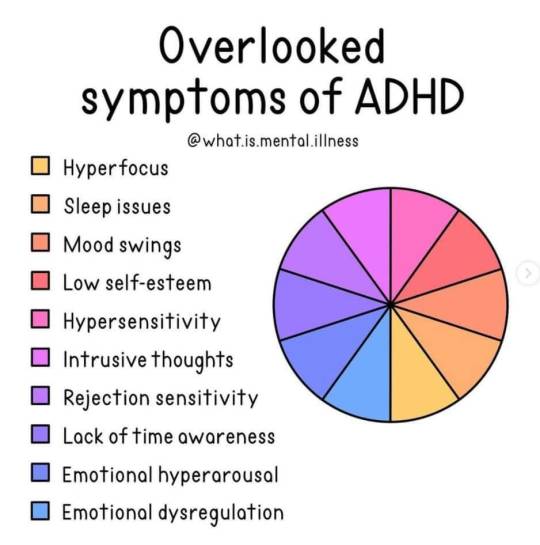
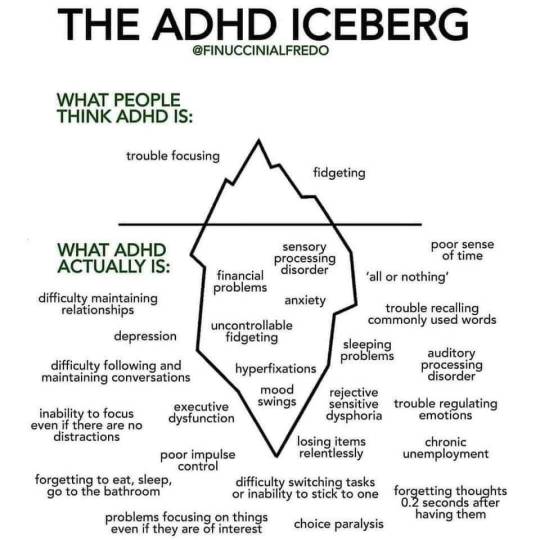


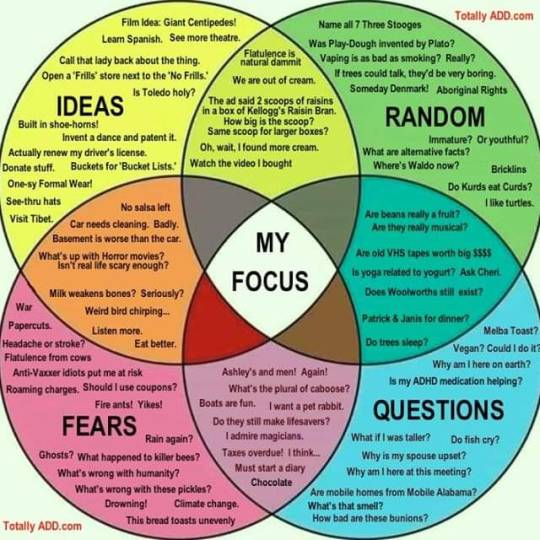
#living with adhd#neurodivergent#undiagnosed adhd#adhd post#adhd brain#adhd things#adhd thoughts#adhd tag#adhd stuff#adhd symptoms#adhd problems
309 notes
·
View notes
Text

NEURODIVERSE-SQUAD, ASSEMBLE!
#neurodiversesquad#adhd memes#neurodivergence#neurodiversity#neurodiverse stuff#adult adhd#adhd#autism#ocd#depression#anxiety#dyslexia#mental health#mental wellbeing#late diagnosis#undiagnosed#self diagnosis is valid#medicated#unmedicated#adhd symptoms#symptoms
888 notes
·
View notes
Text

Source: @jennhasadhd
#this!#adhd symptoms#adhd awareness#adhd memes#adult adhd#undiagnosed adhd#adhd life#adhd#memes#past#sad memes
451 notes
·
View notes
Text
adhd is weird bc i can’t do math but i can learn a song in gaelic in less than an hour
16 notes
·
View notes
Text
Rejection-Sensitive Dysphoria
This is an intense emotional reaction to perceived rejection.
Because executive functions are altered by ADHD, feeling rejected can cause intense and long-lasting feelings, such as disappointment, sadness, shame and regret.
In extreme cases, rejection triggers feelings that are so painful that they invest a lot of energy in pleasing other people in order not to be rejected. Leading to isolation, anxiety, depression, common characteristics in people with ADHD.
#adhd problems#adhd#the struggle of my life#adhd things#adhd brain#anxiety struggles#adhdwomen#adhd symptoms#adhd stuff#adult adhd#living with adhd#my adhd#adhd post#adhd culture#actually adhd
271 notes
·
View notes
Text
Am I in love or is it my ADHD?
#i should probably explain what i meant by this#for me personally i was referring to the symptom “emotional dysregulation”#meaning#my emotions are all over the place#so i can love a person platonically and intensely#causing the confusion#adhd symptoms#adhd brain#actually adhd#adhd problems#adhd things#adhd diagnosis#adhd awareness#mental health#adhd#attention deficit hyperactivity disorder
37 notes
·
View notes
Text
So maybe I'm not color blind and dyslexic, maybe it's just ANOTHER symptom of autism...
Apparently, like auditory processing disorder, visual processing disorder exist!
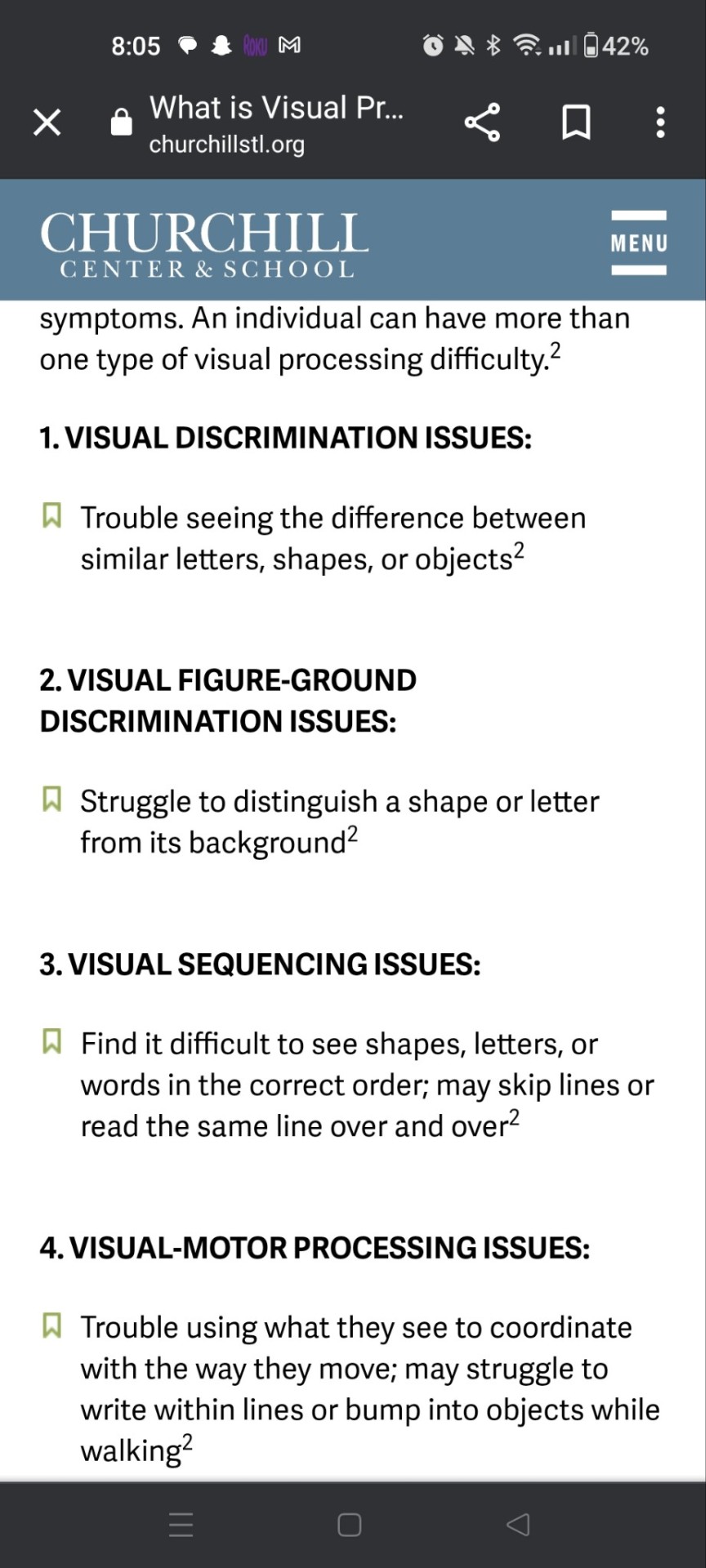

Image description:
1. VISUAL DISCRIMINATION ISSUES:
Trouble seeing the difference between similar letters, shapes, or objects2
2. VISUAL FIGURE-GROUND DISCRIMINATION ISSUES:
Struggle to distinguish a shape or letter from its background2
3. VISUAL SEQUENCING ISSUES:
Find it difficult to see shapes, letters, or words in the correct order; may skip lines or read the same line over and over2
4. VISUAL-MOTOR PROCESSING ISSUES:
Trouble using what they see to coordinate with the way they move; may struggle to write within lines or bump into objects while walking2
5. LONG- OR SHORT-TERM VISUAL MEMORY ISSUES:
Struggle to remember shapes, symbols, or objects they’ve seen, causing issues with reading and spelling2
6. VISUAL-SPATIAL ISSUES:
Trouble understanding where objects are in space; unsure how close objects are to one another2
7. VISUAL CLOSURE ISSUES:
Difficulty identifying an object when only parts of it are showing2
8. LETTER AND SYMBOL REVERSAL ISSUES:
Switch numbers or letters when writing, or may mistake “b” for “d” or “w” for “m”1
#visual processing disorder#autism things#autism spectrum disorder#autism symptoms#autism#adhd symptoms#adhd#audhd#vpd#apd#auditory processing disorder
53 notes
·
View notes